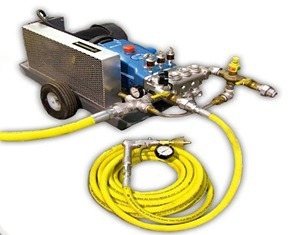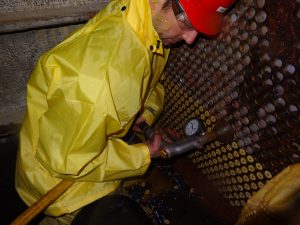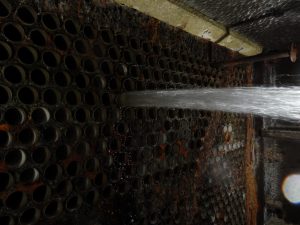Mechanical tube cleaning of condensers and heat exchangers has become one of the most popular cleaning methods in the power generation, refining, and petrochemical industries over the last couple decades. Mechanical tube cleaners have replaced more traditional methods like high-pressure water blasting due to its significant benefits in regards to safety and overall cost savings. With this popularity, there is some debate over different methods of mechanical tube cleaning. There are basically two different methods for cleaning tubes with projectile-based mechanical tube cleaning. The difference between the two methods is based on the source that is pushing the tube cleaners down the tube.
Water Powered Tube Cleaning
This involves using a pumping system (Figure 1) that pressurizes available water up to 600 PSI. Technicians then use a specialized water gun to shoot tube cleaners through each tube (Figure 2). The pumping system pumps at 35 gallons per minute. This large volume of water not only allows for the tube cleaner to be propelled through the tube, but also helps flush out any remaining deposit that is left behind by each tube cleaner (Figure 3).

Figure 1. Water-based Tube Cleaning Pump

Figure 2. Technician using Pumping System to Clean Tubes

Figure 3. Tube Being Flushed of Debris
The pump’s pressure can be adjusted and is usually set for 350-450 PSI. This range is what is considered the optimal range for condenser tube and heat exchanger tube cleaning. This range is best because at these pressures, the tube cleaners usually pass through tubes at a rate of about 15 feet per second. This rate allows for the combination of optimal tube cleaning speed and optimal abrasion against the tube. Typically, if the tube cleaner is traveling faster than 15 feet per second, the tube cleaner can “ride over” or skip some of the deposit in the tube. Thus this results in not removing all the deposit and ultimately a substandard cleaning.
Air And Water
Air and water systems utilize what is essentially an air gun with a water flush. The guns are connected to plant compressed air lines which typically operate between 80-120 PSI. Because the system uses air pressure the tube cleaners pass through heat exchanger tubes at a much faster rate than they would with the water only system. The tube cleaner usually moves at a minimum of 30 feet per second. The water in this method is used to limit the amount of airborne debris and to help flush the tube, but the water is not the main source of propulsion for the tube cleaner.
Which System Is Better?
The answer to this question is based on each customer’s situation. One of the main benefits of the air and water system is that it is easier to use; it is not as physical as using water only and there is no need to lug around heavy pumping systems. The main negative feature of an air-based system is that it will not clean as effectively as the water-only system. The reason for this is one because the large amount of volume used in water-based condenser tube cleaning (35 GPM) creates a flushing action that contributes to deposit removal abilities and two, because the high velocity of the air-based system causes the tube cleaners to skip over deposits. Even small amounts of deposits that are not clinging to the tube, such as mud and silt deposits, can be skipped over at high rates. This can leave an insulatory barrier that can reduce heat exchange and negatively impact overall efficiency. Additionally, with an air-based system, there is a limit on the type of tube cleaners that can be used. Metal tube cleaners cannot be used with air-based systems and only plastic pig and nylon brush types are available for use. Ultimately, the air and water is a less effective system for cleaning heat exchangers and condensers and should only be utilized in rare cases where deposits are very mild. The safest bet for maximum deposit removal from condenser and heat exchanger tubes is the water-only based method.
Projectile Tube Cleaning uses water-based pumping systems for the vast majority of its condenser and heat exchanger cleaning projects, but we can also offer air based cleanings upon request. We also manufacture both air-based and water-based cleaning equipment and will ultimately provide what the customer requests. More information on condenser tube cleaning can be found here on our website: Condenser Cleaning
If you would like more information on this tube cleaning tools and services please do not hesitate to contact us:
